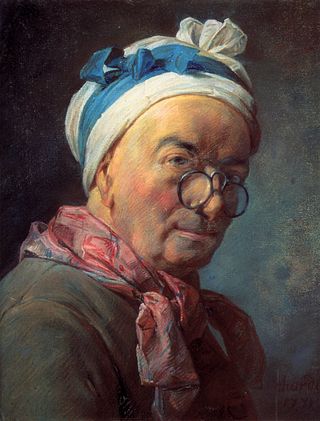
Jean Siméon Chardin was an 18th-century French painter. He is considered a master of still life, and is also noted for his genre paintings which depict kitchen maids, children, and domestic activities. Carefully balanced composition, soft diffusion of light, and granular impasto characterize his work.
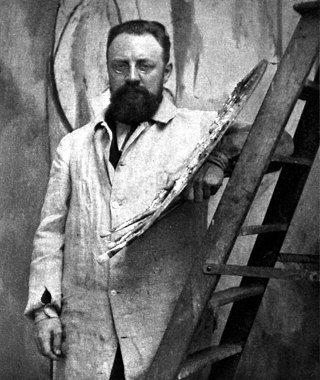
Henri Émile Benoît Matisse was a French visual artist, known for both his use of colour and his fluid and original draughtsmanship. He was a draughtsman, printmaker, and sculptor, but is known primarily as a painter.
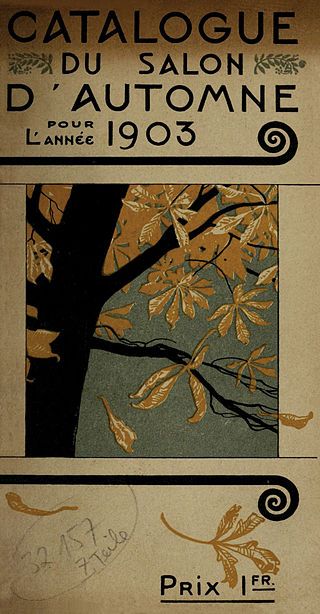
The Salon d'Automne, or Société du Salon d'automne, is an art exhibition held annually in Paris. Since 2011, it is held on the Champs-Élysées, between the Grand Palais and the Petit Palais, in mid-October. The first Salon d'Automne was created in 1903 by Frantz Jourdain, with Hector Guimard, George Desvallières, Eugène Carrière, Félix Vallotton, Édouard Vuillard, Eugène Chigot and Maison Jansen.

The Société des Artistes Indépendants or Salon des Indépendants was formed in Paris on 29 July 1884. The association began with the organization of massive exhibitions in Paris, choosing the slogan "sans jury ni récompense". Albert Dubois-Pillet, Odilon Redon, Georges Seurat and Paul Signac were among its founders. For the following three decades their annual exhibitions set the trends in art of the early 20th century, along with the Salon d'Automne. This is where artworks were often first displayed and widely discussed. World War I brought a closure to the salon, though the Artistes Indépendants remained active. Since 1920, the headquarters has been located in the vast basements of the Grand Palais.

Les Demoiselles d'Avignon is a large oil painting created in 1907 by the Spanish artist Pablo Picasso. Part of the permanent collection of the Museum of Modern Art in New York, it portrays five nude female prostitutes in a brothel on Carrer d'Avinyó, a street in Barcelona, Spain. The figures are confrontational and not conventionally feminine, being rendered with angular and disjointed body shapes, some to a menacing degree. The far left figure exhibits facial features and dress of Egyptian or southern Asian style. The two adjacent figures are in an Iberian style of Picasso's Spain, while the two on the right have African mask-like features. Picasso said the ethnic primitivism evoked in these masks moved him to "liberate an utterly original artistic style of compelling, even savage force" leading him to add a shamanistic aspect to his project.

Louis Vauxcelles was a French art critic. He is credited with coining the terms Fauvism (1905) and Cubism (1908). He used several pseudonyms in various publications: Pinturrichio, Vasari, Coriolès, and Critias.

Albert Marquet was a French painter. He initially became one of the Fauve painters and a lifelong friend of Henri Matisse. Marquet subsequently painted in a more naturalistic style, primarily landscapes, but also several portraits and, between 1910 and 1914, several female nude paintings.
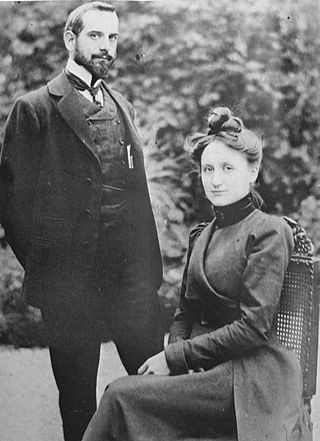
Henri Charles Manguin was a French painter, associated with the Fauves.

Georgette Agutte was a French painter.
Marie-Alain Couturier, O.P., was a French Dominican friar and Catholic priest, who gained fame as a designer of stained glass windows. He was noted for his modern inspiration in the field of Sacred art.

Woman with a Hat is an oil-on-canvas painting by Henri Matisse. It depicts Matisse's wife, Amélie Matisse. It was painted in 1905 and exhibited at the Salon d'Automne during the autumn of the same year, along with works by André Derain, Maurice de Vlaminck and several other artists later known as "Fauves".

Le bonheur de vivre is a painting by Henri Matisse. Along with Picasso's Les Demoiselles d'Avignon, Le bonheur de vivre is regarded as one of the pillars of early modernism. The monumental canvas was first exhibited at the Salon des Indépendants of 1906, where its cadmium colors and spatial distortions caused a public expression of protest and outrage.

The Matisse Museum is a museum in Le Cateau-Cambrésis, France that primarily displays paintings by Henri Matisse. The museum was established by Matisse himself on 8 November 1952; he also defined the way his works should be arranged. At that time the museum was located in the wedding room of the Le Cateau City Hall.

Luxe, Calme et Volupté is a 1904 oil painting by the French artist Henri Matisse. Both foundational in the oeuvre of Matisse and a pivotal work in the history of art, Luxe, Calme et Volupté is considered the starting point of Fauvism. This painting is a dynamic and vibrant work created early on in his career as a painter. It displays an evolution of the Neo-Impressionist style mixed with a new conceptual meaning based in fantasy and leisure that had not been seen in works before.

Fauvism is a style of painting and an art movement that emerged in France at the beginning of the 20th century. It was the style of les Fauves, a group of modern artists whose works emphasized painterly qualities and strong colour over the representational or realistic values retained by Impressionism. While Fauvism as a style began around 1904 and continued beyond 1910, the movement as such lasted only a few years, 1905–1908, and had three exhibitions. The leaders of the movement were André Derain and Henri Matisse.
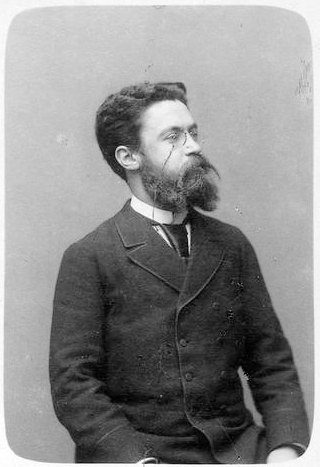
Marcel Sembat was a French Socialist politician. He served as a member of the National Assembly of France from 1893 to 1922, and as Minister of Public Works from August 26, 1914, to December 12, 1916.

Proto-Cubism is an intermediary transition phase in the history of art chronologically extending from 1906 to 1910. Evidence suggests that the production of proto-Cubist paintings resulted from a wide-ranging series of experiments, circumstances, influences and conditions, rather than from one isolated static event, trajectory, artist or discourse. With its roots stemming from at least the late 19th century, this period is characterized by a move towards the radical geometrization of form and a reduction or limitation of the color palette. It is essentially the first experimental and exploratory phase of an art movement that would become altogether more extreme, known from the spring of 1911 as Cubism.

Femme au Chapeau is an oil painting by the French artist and theorist Jean Metzinger, created c. 1906. The work is executed in a highly personal Divisionist style with a marked Proto-Cubist component during the height of Fauvism. Femme au Chapeau exhibits a presentiment of Metzinger's subsequent interest in the faceting of form associated with Cubism. The painting is part of the collection of the Korban Art Foundation.

Portrait of Marguerite de Conflans is a c.1876 oval oil on canvas portrait by the French painter Édouard Manet. It is owned by the Musée d’Orsay, though it is on display in the red salon at the Musée des Augustins in Toulouse. Like A Bar at the Folies-Bergère, the work mimics Ingres in its use of a mirror to show the figure from several angles, a motif rarely used by Manet.

The Red Carpets is a 1906 oil on canvas still life painting, produced in Collioure by Henri Matisse. It was bought by Marcel Sembat from the galerie Bernheim-Jeune in 1908 and is now in the Museum of Grenoble, to which it was left as part of the collections of Sembat and his wife Georgette Agutte in 1923.

















